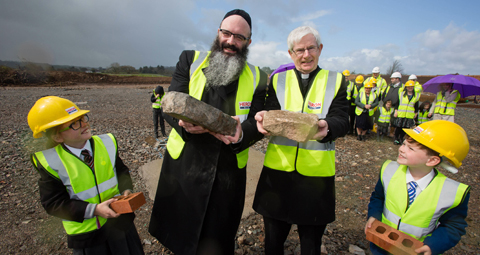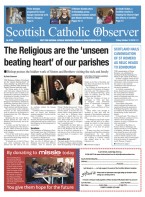May 5 | ![]() 0 COMMENTS
0 COMMENTS ![]() print
print

A quiet revolution in faith schooling
In the autumn, Jewish and Catholic primary schools will share one campus. Stephen Daisley reports.
IN a leafy suburb on the outskirts of Glasgow, a quiet revolution in faith schooling is under way. Pupils and teachers in Newton Mearns might be counting down the weeks till the summer holidays but come the autumn they launch a bold experiment. For around 650 youngsters will start the next school year at a new multi-denominational campus, located across from Mearns Castle High School.
It will be home to Calderwood Lodge, a Jewish primary school currently situated in Newlands on the south side of Glasgow, and St Clare’s, a new Catholic primary which will draw its 444 pupils in part from the roll of St Cadoc’s. It is believed to be the first facility of its kind in the world. The £18.2 million campus will allow the two schools to retain their individual identities, with their own classrooms, headteachers, and parent-teacher councils.
But the two buildings will be joined by an atrium where children from both schools will be able to socialise, as well as a common playground and shared facilities for sports, art, science, music and drama.
A separate dining room will be provided for Calderwood Lodge pupils, serving meals prepared in accordance with kashrut, the halakhic dietary laws.
Anne Marie Absolom, who will serve as headteacher at St Clare’s, believes the venture symbolises the value of interfaith partnership without diluting the distinct faith traditions involved.
“The bringing together of new Jewish and Catholic primary schools on a single campus is a momentous initiative,” she said. “It delivers a powerful message to the wider community that two different faiths can work in close cooperation whilst retaining their own unique identity.
“It’s an exciting venture that East Renfrewshire can be rightly proud of. Once opened, the two schools will work closely together to the benefit of our children and the wider community.”
The credit for this forward-thinking approach goes to parents, teachers and the local authority. However, there are older antecedents, and two men in particular are due recognition.
The warm relations between Catholics and Jews today are typically traced to the efforts of John Paul II. It is true that he embraced Jews as ‘our elder brothers’ and ‘the people of the Old Covenant never revoked by God’; visited and prayed at the Western Wall; and expressed sorrow for Christian anti-Semitism in a speech at Yad Vashem, the Holocaust Remembrance Centre in Jerusalem, Israel.
Upon his death in 2005, the Anti-Defamation League, America’s premier Jewish organisation, declared: “More change for the better took place in his 27-year papacy than in the nearly 2,000 years before.”
But the saint’s work built upon the endeavours of Pope John XXIII, whose contributions to post-war reconciliation cannot be overstated.
It was John XXIII who halted the celebration of Mass during Holy Week 1959 to decree that the reference to ‘perfidious’ Jews be expunged from the liturgy. He laid the groundwork for Nostra Aetate, the repudiation of the Jewish deicide doctrine, and which instructed that ‘the Church… decries hatred, persecutions, displays of anti-Semitism, directed against Jews at any time and by anyone.’
All the more remarkable was his bravery prior to assuming the papacy. As Archbishop Angelo Roncalli, he was posted to Istanbul in 1934, where he ran an anti-Nazi underground, providing thousands of Jews with forged papers that allowed them to escape to Palestine.
When he was canonised in 2014, the Knesset held a special session in honour of his memory, an unprecedented event in the history of Israel’s parliament.
As two minority faiths, it would seem to make sense that Scotland’s Jews and her Catholics forge common cause. Dr Kenneth E Collins, in his study Scotland’s Jews, describes ‘an open society where anti-semitism has rarely been a feature of Scottish life.’
This accords with the historical record on anti-Jewish violence in Scotland, although the rise of ‘new anti-Semitism,’ in which prejudice against Jews is cloaked in criticism of Israel, poses a disturbing challenge.
Here we find another intertwining of the Catholic and Jewish experience, for historians contend that Presbyterian Scotland’s anti-Catholicism deflected bigotry that in other societies would have been directed at Jews.
As Professor Aubrey Newman has bluntly put it: “There was apparently more tolerance of Jews in Scotland and Glasgow because the Catholics and Protestants hated each other so much that they had no hatred left.”
The Newton Mearns campus may be groundbreaking, but the soil was tilled by many hands over many years.
If Calderwood/St Clare’s is a blessing for parents who want their children to benefit from an ethos-centred education, it is a development that levels difficult questions at secular campaigners, depriving them of some of the most media-friendly attack lines against denominational instruction.
Far from fostering division, here is a faith school that brings together children (and staff) from diverse religious and cultural backgrounds.
The architecture respects difference while also encouraging unity, with discrete areas for worship and shared spaces for recreation and creativity. There is even a non-denominational nursery catering for 100 toddlers.
As Marion Carlton, headteacher of the 210-roll Calderwood Lodge, said: “We are so excited about the move to the new joint campus for the start of the next session. The design has been based on feedback from parents and representatives from both faith communities and I know it will provide us with a fantastic learning environment.
“It will give excellent opportunities for shared learning and interaction amongst all the pupils and staff. Bringing together these two faith communities on one campus is creative and innovative and I have no doubt we will all reap the benefits from this approach.”
The Newton Mearns model points to a rejuvenated future for denominational schools and could see East Renfrewshire become a leader for inclusive, ethos-based education.
That will require faith communities to study this experiment and learn from it —to make alliances and explore the potential for the model to be adopted elsewhere. Future strength may lie in numbers.
As for the pupils of Calderwood Lodge and St Clare’s, they will be heading back to school in the autumn, excited to be reunited with friends, eager to make new ones, and blissfully unaware that they are pioneers for the next generation of faith schools.
Stephen Daisley is a columnist for the Scottish Daily Mail.











